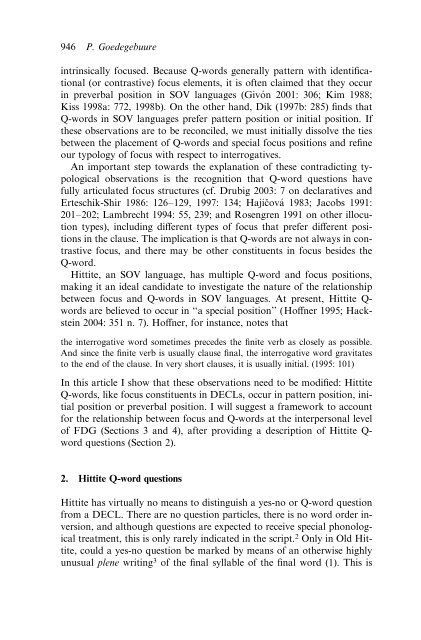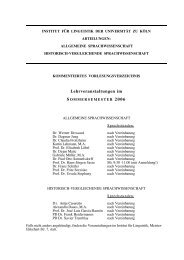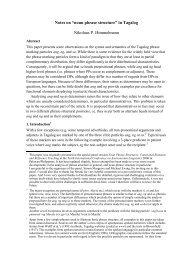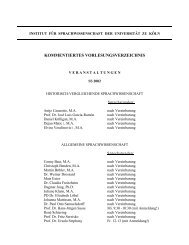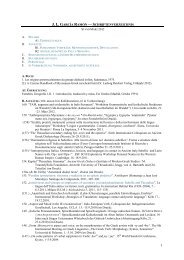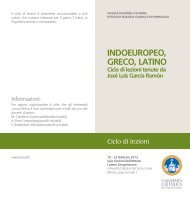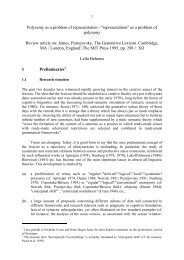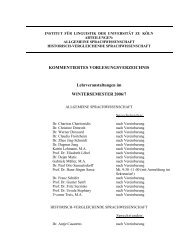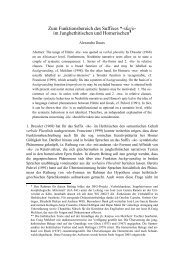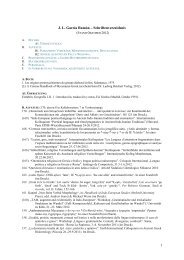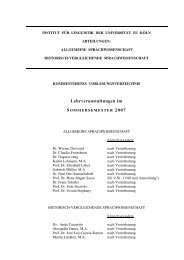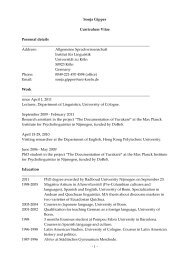Topics in Anatolian Historical Grammar Prof. Dr. H. Craig Melchert
Topics in Anatolian Historical Grammar Prof. Dr. H. Craig Melchert
Topics in Anatolian Historical Grammar Prof. Dr. H. Craig Melchert
Create successful ePaper yourself
Turn your PDF publications into a flip-book with our unique Google optimized e-Paper software.
946 P. Goedegebuure<br />
<strong>in</strong>tr<strong>in</strong>sically focused. Because Q-words generally pattern with identificational<br />
(or contrastive) focus elements, it is often claimed that they occur<br />
<strong>in</strong> preverbal position <strong>in</strong> SOV languages (Givón 2001: 306; Kim 1988;<br />
Kiss 1998a: 772, 1998b). On the other hand, Dik (1997b: 285) f<strong>in</strong>ds that<br />
Q-words <strong>in</strong> SOV languages prefer pattern position or <strong>in</strong>itial position. If<br />
these observations are to be reconciled, we must <strong>in</strong>itially dissolve the ties<br />
between the placement of Q-words and special focus positions and ref<strong>in</strong>e<br />
our typology of focus with respect to <strong>in</strong>terrogatives.<br />
An important step towards the explanation of these contradict<strong>in</strong>g typological<br />
observations is the recognition that Q-word questions have<br />
fully articulated focus structures (cf. <strong>Dr</strong>ubig 2003: 7 on declaratives and<br />
Erteschik-Shir 1986: 126–129, 1997: 134; Hajičová 1983; Jacobs 1991:<br />
201–202; Lambrecht 1994: 55, 239; and Rosengren 1991 on other illocution<br />
types), <strong>in</strong>clud<strong>in</strong>g di¤erent types of focus that prefer di¤erent positions<br />
<strong>in</strong> the clause. The implication is that Q-words are not always <strong>in</strong> contrastive<br />
focus, and there may be other constituents <strong>in</strong> focus besides the<br />
Q-word.<br />
Hittite, an SOV language, has multiple Q-word and focus positions,<br />
mak<strong>in</strong>g it an ideal candidate to <strong>in</strong>vestigate the nature of the relationship<br />
between focus and Q-words <strong>in</strong> SOV languages. At present, Hittite Q-<br />
words are believed to occur <strong>in</strong> ‘‘a special position’’ (Ho¤ner 1995; Hackste<strong>in</strong><br />
2004: 351 n. 7). Ho¤ner, for <strong>in</strong>stance, notes that<br />
the <strong>in</strong>terrogative word sometimes precedes the f<strong>in</strong>ite verb as closely as possible.<br />
And s<strong>in</strong>ce the f<strong>in</strong>ite verb is usually clause f<strong>in</strong>al, the <strong>in</strong>terrogative word gravitates<br />
to the end of the clause. In very short clauses, it is usually <strong>in</strong>itial. (1995: 101)<br />
In this article I show that these observations need to be modified: Hittite<br />
Q-words, like focus constituents <strong>in</strong> DECLs, occur <strong>in</strong> pattern position, <strong>in</strong>itial<br />
position or preverbal position. I will suggest a framework to account<br />
for the relationship between focus and Q-words at the <strong>in</strong>terpersonal level<br />
of FDG (Sections 3 and 4), after provid<strong>in</strong>g a description of Hittite Q-<br />
word questions (Section 2).<br />
2. Hittite Q-word questions<br />
Hittite has virtually no means to dist<strong>in</strong>guish a yes-no or Q-word question<br />
from a DECL. There are no question particles, there is no word order <strong>in</strong>version,<br />
and although questions are expected to receive special phonological<br />
treatment, this is only rarely <strong>in</strong>dicated <strong>in</strong> the script. 2 Only <strong>in</strong> Old Hittite,<br />
could a yes-no question be marked by means of an otherwise highly<br />
unusual plene writ<strong>in</strong>g 3 of the f<strong>in</strong>al syllable of the f<strong>in</strong>al word (1). This is


